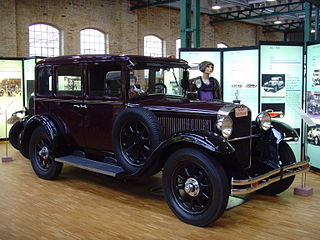Related Research Articles

The Mercedes-Benz E-Class is a range of executive cars manufactured by German automaker Mercedes-Benz in various engine and body configurations. Produced since 1953, the E-Class falls midrange in the Mercedes line-up, and has been marketed worldwide across five generations.

The Mercedes-Benz W211 is the third generation Mercedes-Benz E-Class made from 2001 to 2009 in sedan/saloon and station wagon/estate configurations – replacing the W210 E-Class models and superseded by the Mercedes-Benz W212 in 2009.

The Mercedes-Benz Mannheim 350 replaced the W03/Typ 350 models in 1929. The structure originated by Ferdinand Porsche was modified by Hans Nibel.

The Mercedes-Benz W18 was a six-cylinder automobile introduced as the Mercedes-Benz Typ 290 in 1933. It was a smaller-engined successor to the manufacturer’s Typ 350 / 370 Mannheim model. In terms of the German auto-business of the 1930s it occupied a market position roughly equivalent to that filled by the Mercedes-Benz E-Class in the closing decades of the twentieth century. The W18 was replaced in 1937 by the manufacturer’s W142.

The Mercedes-Benz W11 was a midsize six-cylinder automobile introduced by Daimler-Benz it 1929. It was developed from the Mercedes-Benz W02 first seen in 1926, and the W11 shared its chassis and bodywork with the W02, but the W11 came with a larger more powerful engine, a new name and a wider list of “standard bodies” from which customers could choose.

The Mercedes-Benz W03 was a large six-cylinder-engined automobile introduced as the Mercedes-Benz 12/55 PS and, initially, as the Mercedes-Benz Typ 300, by Daimler-Benz at the Berlin Motor Show in October 1926. It was developed in some haste under the manufacturer's Technical Director, Ferdinand Porsche in parallel with the smaller Mercedes-Benz W 01 and the two-litre-engined Mercedes-Benz W02 following the creation of Daimler-Benz, formally in July 1926, from the fusion of the Daimler and Benz & Cie auto-businesses.

The Mercedes-Benz W205 is the fourth generation of the Mercedes-Benz C-Class which was produced by Daimler AG between 2014 and 2021. The W205 C-Class was preceded by the W204 C-Class and superseded by the W206 C-Class. The fourth-generation C-Class was available in sedan (W205), station wagon/estate (S205), coupe (C205), cabriolet (A205) and long-wheelbase sedan (V205) body styles.

The Mercedes-Benz C-Class (W206) is the fifth generation of the Mercedes-Benz C-Class which is produced by Mercedes-Benz Group AG since 2021. It replaces the W205 C-Class which has been produced since 2014. The fifth-generation C-Class is available in sedan (W206), station wagon/estate (S206), and long-wheelbase sedan (V206) body styles. The W206 C-Class is based on the Mercedes MRA II rear-wheel drive modular platform also used by the W223 S-Class.
The Mercedes-Benz M24 engine is a supercharged, 5.0-liter and 5.4-liter, straight-8 engine, designed, developed and produced by Mercedes-Benz; between 1934 and 1944.
The Mercedes-Benz M19 engine is a naturally-aspirated, 3.8-liter, straight-8 engine, designed, developed and produced by Mercedes-Benz; between 1932 and 1933.
The Mercedes-Benz M08 engine is a naturally-aspirated and supercharged, 4.6-liter and 5.0-liter, straight-8 engine, designed, developed and produced by Mercedes-Benz; between 1928 and 1940.
The Mercedes-Benz M142 engine is a naturally-aspirated, 3.2-liter to 3.4-liter, straight-6, internal combustion piston engine, designed, developed and produced by Mercedes-Benz; between 1937 and 1942.
The Mercedes-Benz M21 engine is a naturally-aspirated, 2.0-liter, straight-6, internal combustion piston engine, designed, developed and produced by Mercedes-Benz; between 1933 and 1936.
The Mercedes-Benz M11 engine is a naturally-aspirated, 2.6-liter, straight-6, internal combustion piston engine, designed, developed and produced by Mercedes-Benz; between 1929 and 1935.
The Mercedes-Benz M06 engine is a supercharged, 6.8-liter to 7.1-liter, straight-6, internal combustion piston engine, designed, developed and produced by Mercedes-Benz; between 1928 and 1934.
The Mercedes-Benz M09 engine is a naturally-aspirated, 3.4-liter, straight-6, internal combustion piston engine, designed, developed and produced by Mercedes-Benz; between 1928 and 1929.
The Mercedes-Benz M04 engine is a naturally-aspirated, 3.0-liter and 3.1-liter, straight-6, internal combustion piston engine, designed, developed and produced by Mercedes-Benz; between 1927 and 1928.
The Mercedes-Benz M02 engine is a naturally-aspirated, 2.0-liter, straight-6, internal combustion piston engine, designed, developed and produced by Mercedes-Benz; between 1926 and 1933.
The Daimler-Mercedes M9456 engine is a supercharged and naturally-aspirated, 6.2-liter to 6.4-liter, straight-6, internal combustion piston engine, designed, developed and produced by Mercedes-Benz, in partnership with Daimler; between 1924 and 1929.
The Daimler-Mercedes M836 engine is a naturally-aspirated and supercharged, 3.9-liter to 4.0-liter, straight-6, internal combustion piston engine, designed, developed and produced by Mercedes-Benz, in partnership with Daimler; between 1924 and 1929.
References
- ↑ "Mercedes-Benz M10 Engine". Sportlichleicht.com. Retrieved 10 November 2021.
- ↑ "MERCEDES BENZ Typ Mannheim Sedan (W10) specs & photos - 1929, 1930, 1931, 1932, 1933, 1934". Autoevolution. Retrieved 10 November 2021.
- ↑ "1929 Mercedes-Benz 14/70 hp Type Mannheim 350 W 10 specifications | technical data | performance | fuel economy | emissions | dimensions | horsepower | torque | weight". Carfolio.com. Retrieved 10 November 2021.
- ↑ Fayda Bilişim. "Mercedes-Benz Typ 400 (1924 - 1929)". Autovehicle.info. Retrieved 10 November 2021.
- ↑ "MERCEDES BENZ Typ Mannheim Sedan (W10) 370 vs MERCEDES BENZ Typ Mannheim Sedan (W10) 350". Autointro.net. Retrieved 10 November 2021.
- ↑ "MERCEDES BENZ Typ Mannheim Sedan (W10) 380 S vs MERCEDES BENZ Typ Mannheim Sedan (W10) 350". Autointro.net. Retrieved 10 November 2021.